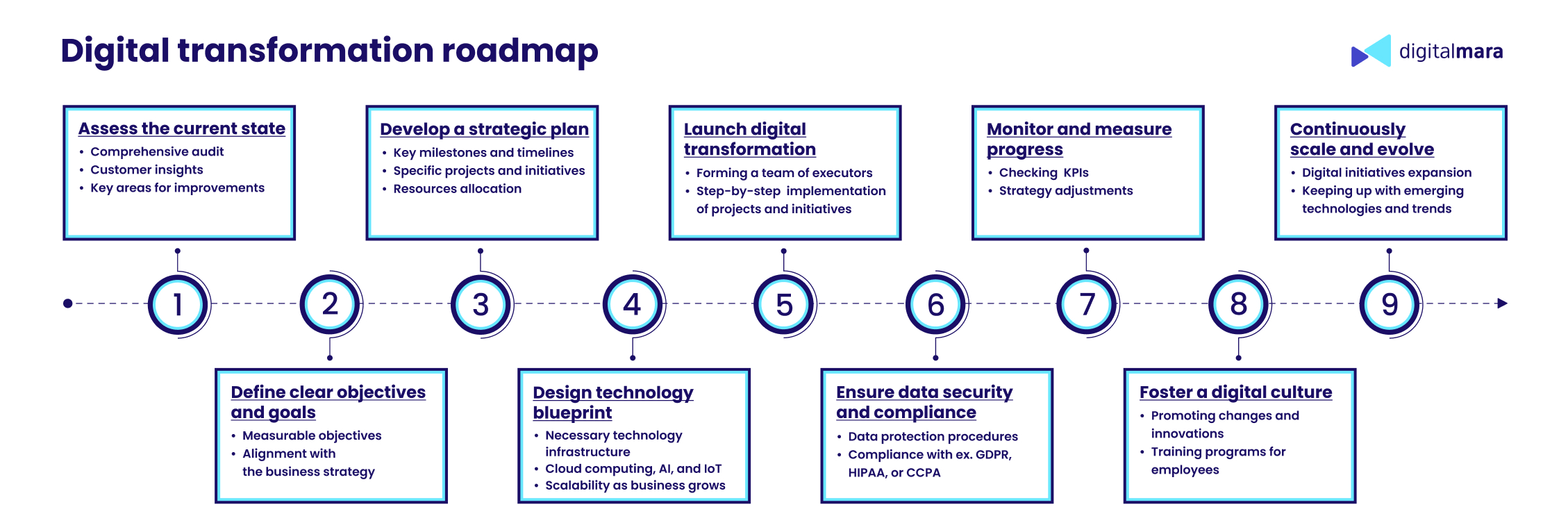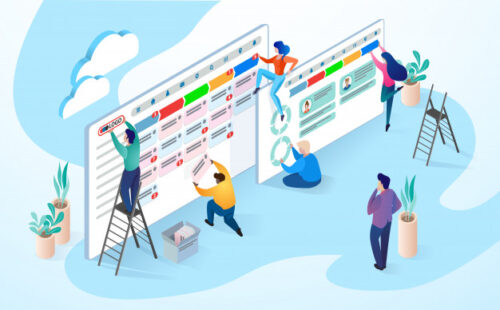In today’s rapidly evolving business landscape, digital transformation has become essential for organizations striving to remain competitive and relevant. According to Statista, global spending on IT solutions is projected to exceed $4 trillion by 2027. Digital transformation involves the comprehensive integration of digital technologies across all business areas, fundamentally altering how companies operate and deliver value to customers. Leveraging our expertise in custom software development, DigitalMara has prepared a detailed guide on digital transformation best practices. This guide outlines the roadmap, core components, and technologies necessary for a successful digital transformation journey.
Digital transformation roadmap
Digital transformation is a complex process that covers numerous aspects of the business and requires thorough preparation. A well-structured roadmap, featuring IT strategy development, helps in navigating this journey. From start to finish, it outlines key phases. By following a comprehensive plan, businesses can effectively harness the power of digital technologies. This chapter provides practical insights and strategies for each phase.

Step 1. Assess the current state
To understand where you are, you need to analyze all available data within the company. Internal information resources include:
- a comprehensive audit of existing systems, such as technologies, software, and processes in use;
- feedback from employees who are involved in key operations in various departments, to understand pain points;
- insights from customers, to understand their needs, preferences, and problematic areas.
SWOT analysis is also a good way to define a company’s strengths, weaknesses, opportunities, and threats in the digital landscape. A comprehensive view enables you to compare the current digital maturity of the company with industry standards and competitors.
The results of a thorough analysis form the basis for identifying key areas that need improvement. These can be outdated technologies, inefficient processes, or a poor customer experience—everything that has an impact on business objectives and success.
Step 2. Define clear objectives and goals
For digital transformation to bring tangible results, its goals need to be aligned with business strategy from a long-term perspective. Setting SMART objectives (specific, measurable, achievable, relevant, and time-bound) is crucial in this process. Performance metrics and KPIs are suitable for tracking progress. The potential metrics are highly diverse. Some examples include customer satisfaction scores, revenue growth, operational efficiency metrics, website traffic and conversion rates, system downtime and uptime, and cost savings from automation. And innovation rates, such as the number of new digital products or services launched.
Regular review and adjustments to these objectives are necessary to ensure alignment with business goals and to maintain focus. This enables timely identification of any deviations from the planned outcomes and proactive interventions to address issues. Also, for example, new opportunities that were not initially visible may arise.
Step 3. Develop a strategic plan
After defining your goals and desired outcomes, it’s time to build a detailed strategic plan. This will encompass specific projects and initiatives, key milestones, and timelines. Large projects should be divided into manageable tasks with clear deliverables. On this basis, we can allocate the necessary resources, including financial resources, human resources, and technologies. It’s also necessary to identify potential risks and develop mitigation strategies, keeping a contingency budget for unexpected challenges.
An essential point of the plan is to identify the necessary partnerships and collaborations needed to gain expertise, services, resources, and even strategic guidance. These partners can support custom software development, IT augmentation services, cloud services, cybersecurity, data analytics, and more.
For everything to be successful, all key stakeholders must be familiar with the plan and understand their roles. This includes executives, project managers, team members, and external partners. Effective communication channels help to keep everyone informed about progress, changes, and important decisions.
Step 4. Design technology blueprint
Digital transformation involves creating new technology infrastructure. This may mean legacy software upgrading and creating completely new components. The blueprint must comprehensively address hardware, software, and network requirements. It’s necessary to consider such factors as:
- Scalability and flexibility. New infrastructure should be able to scale both vertically and horizontally as the business grows. For example, microservices implementation helps to achieve this.
- Integration. New technologies must integrate smoothly with existing systems and processes to avoid disruptions. This involves compatibility assessments.
- Security and compliance. Initially, robust cybersecurity measures should be incorporated to protect data and systems. These need to be built in compliance with relevant regulations and industry standards.
Choosing the right technologies is a crucial task. The selection should be based on how well these technologies can support and enhance the desired outcomes of the digital transformation. Some key technologies include cloud computing, Artificial Intelligence (AI) Internet of Things (IoT), Big Data analytics, cybersecurity technologies, edge computing, Java development, process automation technologies, and others.
Step 5. Launch digital transformation
This stage involves working with the software directly. A strong tech team is needed, including solution architects, software developers, data scientists, DevOps engineers, QA specialists, security engineers, and project managers. The company can form an internal team or choose IT outsourcing with a dedicated team. Both approaches have their own specific merits. However, there are several crucial needs to consider:
- engaging different specialists at various project stages to ensure efficient use of resources.
- allocating the budget wisely by deploying resources where they are most needed at each stage of the project.
- flexible staffing that allows for scaling the team up or down based on the project needs.
A strategic plan determines the phases of transformation and the order of projects and initiatives. Such a step-by-step approach allows you to manage risks and ensure a smooth transition. New technologies and processes can be tested on a smaller scale. Thus, it’s necessary to stay proactive and be ready to adjust based on immediate feedback.
Step 6. Ensure data security and compliance
Often, systems that need to be transformed lack the proper level of data security and compliance with industry standards. That’s why security is a separate point on the digital transformation roadmap. The company should develop a robust policy to safeguard sensitive information and ensure privacy. Data encryption, access control, and regular security audits are obligatory measures, accompanied by a plan for responding to data breaches and security incidents, endpoint security solutions and data loss prevention tools.
Compliance is also an important part of the policy. Basic regulations include GDPR, HIPAA, and CCPA. Regular review of compliance requirements allows you to update policies and procedures on time. Compliance management software can help you keep abreast.
Step 7. Monitor and measure progress
Continuous monitoring is conducted based on earlier defined indicators – various metrics and KPIs. Dashboards and analytics tools enable tracking and visualizing figures in real-time. Transparency and data accuracy are crucial to get a fair evaluation of the results. And all stakeholders should stay updated on successes or failures and review progress against the set objectives and KPIs. Such an approach ensures you don’t miss the moment when adjustments and improvements are needed.
Step 8. Foster a digital culture
After modernization, it’s necessary to train employees on how to use new technologies and processes. This can involve both formal training sessions and informal learning opportunities, such as workshops, webinars, and online courses. In turn, digital culture in a company involves a culture of innovation and continuous improvement. In practice, it means capturing ideas from employees through cross-functional collaboration and open communication channels.
Step 9. Continuously scale and evolve
Digital transformation is an ongoing process, expanding digital initiatives to new areas of the business and exploring new opportunities for digital innovation. It’s always necessary to keep an eye on emerging technologies and industry trends to maintain a competitive edge. All IT solutions for digital transformation must be scalable to support long-term growth and evolving business needs.
Components of digital transformation
A good digital transformation strategy focuses on critical areas of the company’s operations, leveraging advanced technologies and strategic approaches to optimize operations, improve internal processes, enhance customer satisfaction, and achieve sustainable growth. Some key aspects include enhancing operational efficiency, utilizing data-driven decision-making, and fostering superior customer experiences.
Operational efficiency
Operational efficiency is a crucial component of business success, involving optimizing processes, improving productivity, and reducing costs. Implementing modern technologies can significantly enhance operational efficiency in several key areas:
Process automation
Automating routine and repetitive tasks brings numerous benefits. It reduces the time and effort required for manual tasks, allowing employees to focus on higher-value activities. Automated processes minimize human error and enhance accuracy and reliability. Cloud technologies and Artificial Intelligence (AI) play a significant role in this area and provide access to advanced computational power. Automation can be implemented across all industries for various use cases. Some examples are:
Customer service: Chatbots, powered by Natural Language Processing (NLP) and Machine Learning (ML), provide instant responses and support, improving customer satisfaction and reducing the workload for human agents.
Finance: intelligent automation technologies can automate invoice processing, financial reporting, and other tasks, increasing efficiency and accuracy.
Human resources: Automated recruitment platforms use AI to screen resumes and match candidates, while automated payroll systems ensure timely and accurate payment processing.
Digital supply chain
Integrating digital technologies into supply chain management improves visibility, agility, and coordination. Key technologies:
IoT devices and sensors enable real-time monitoring of inventory levels, shipment locations, and environmental conditions, providing critical data to manage supply chain operations effectively. This technology works well for warehouses and transportation. Furthermore, edge computing empowers processing data closer to where it is generated, reducing latency and bandwidth use.
Predictive analytics is advanced analytics, powered by AI algorithms. It allows for forecasting demand, optimizing inventory levels, and preventing stockouts or overstock situations. In logistics, AI-powered route planning tools analyze traffic patterns, weather conditions, and other variables to determine the most efficient delivery routes, reducing transportation costs and delivery times.
Data-driven decision-making
Data is the fundamental basis for informed decision-making in today’s business landscape. Companies should leverage Big Data and Business Intelligence (BI) tools to enhance their decision-making processes. These technologies enable businesses to analyze vast volumes of data, uncovering valuable insights and identifying patterns that can drive strategic actions.
Interactive dashboards display real-time data, allowing for continuous monitoring of KPIs and operational metrics. This visibility highlights inefficiencies and areas needing improvement. Decisions backed by data reduce reliance on guesswork, leading to more accurate outcomes. AI and ML algorithms can predict future trends and outcomes based on historical data. Additionally, these technologies can automate data analysis, reducing human error and increasing efficiency.
To fully leverage the power of data, it is essential to organize secure data storage to protect against breaches and unauthorized access and integrate various data sources to create a comprehensive data ecosystem. Scalable infrastructure can handle growing amounts of data, and cloud-based platforms provide the necessary resources to manage and analyze large datasets efficiently.
Customer experience
Customer experience is another important component of digital transformation. It is about upgrading the ways they interact with a company. Seamless, personalized, and engaging experiences that meet all of the customers’ expectations.
Omnichannel experience
An omnichannel experience provides customers with a seamless and cohesive journey across all touchpoints, including websites, mobile apps, social media, email, and more. Achieving a consistent experience involves seamless channel switching and unified customer profiles, ensuring that customers can switch between channels without any disruptions. Any interaction, whether a service query or a sales transaction, is displayed consistently across platforms. For instance, a customer can start an interaction on one touchpoint and complete it on another without losing any information.
The user interface and user experience should be responsive and user-friendly, adapting seamlessly to various devices to enhance usability and accessibility. This includes visual components, navigation, fast loading times, and functional performance.
Personalization and engagement
Personalization involves tailoring the customer experience to individual preferences and behaviors, while engagement refers to meaningful interactions with customers that foster deeper connections. Both elements are essential for building loyalty and enhancing customer satisfaction. Modern approaches to personalization and engagement rely on data collection and analytics. By integrating customer data from various channels, businesses can gain a holistic view of each customer, consolidating information such as purchase history, browsing behavior, and other interactions. Advanced analytics, using AI and ML algorithms, enable deeper analysis and more precise personalization, ensuring that interactions are relevant and engaging.
Technologies for digital transformation
By integrating modern technologies, companies can achieve greater agility and efficiency. These innovations drive transformative change across various business operations. The table below lists key technologies and their primary functions. These serve equally well for both legacy software upgrading and creating new software solutions.
| Technology | Main functions |
| Cloud technologies | Provide scalable and secure storage, robust infrastructure, and enhanced software development with cloud-based tools and services. This includes microservices implementation, eliminating the need for on-premises infrastructure and supporting remote work and collaboration. |
| Artificial Intelligence (AI) | Analyzes large volumes of data to extract meaningful insights and enables predictive analytics, enhances customer interactions, automates operations and supports data-driven decision-making. |
| Big Data | Collects, stores, and analyzes vast amounts of structured and unstructured data, enables real-time processing and analytics, and supports data-driven decision-making by uncovering trends and patterns. |
| Internet of Things (IoT) | Connects sensors and devices for real-time data collecting, enhances operational efficiency, and enables remote control. |
| Cybersecurity | Protects systems from cyber threats and safeguards sensitive data from breaches, ensures regulatory compliance and data privacy, and manages risk through early threat detection and proactive responses. |
| Augmented Reality (AR) | Provides interactive and immersive experiences by overlaying digital content on the real world, supports realistic simulations, and enhances product visualization. |
| Java development | A versatile language with a robust ecosystem. Ideal for enterprise applications. Java supports microservices architecture and seamlessly integrates with modern solutions such as IoT, Big Data, and AI. |
Digital transformation through IT outsourcing
By integrating IT outsourcing into their digital transformation strategy, companies can access specialized expertise, advanced technologies, and scalable solutions without the significant investment required to build these capabilities in-house. They can focus on their core competencies while entrusting the development, implementation, and management of digital solutions to experienced external partners. This approach also provides the flexibility to scale resources up or down based on project demands, ensuring that businesses can adapt swiftly to changing market conditions.
DgitalMara can be your reliable partner on this path, thanks to expertise developed on projects of varying complexity and a variety of business domains. Choose our IT staff augmentation or custom software development services.


































